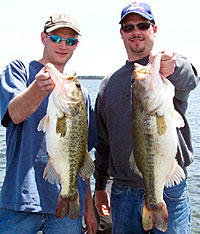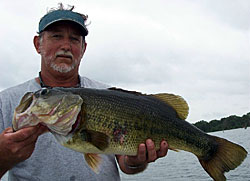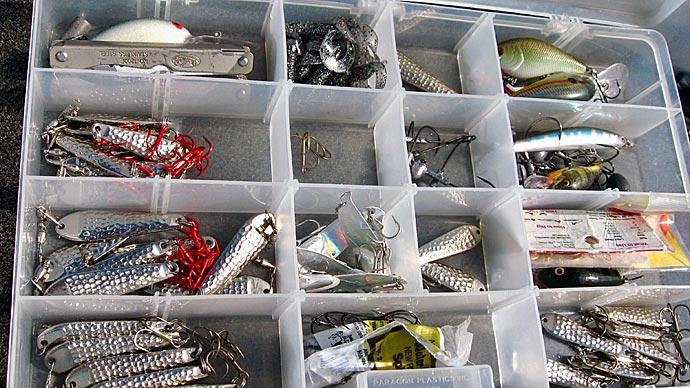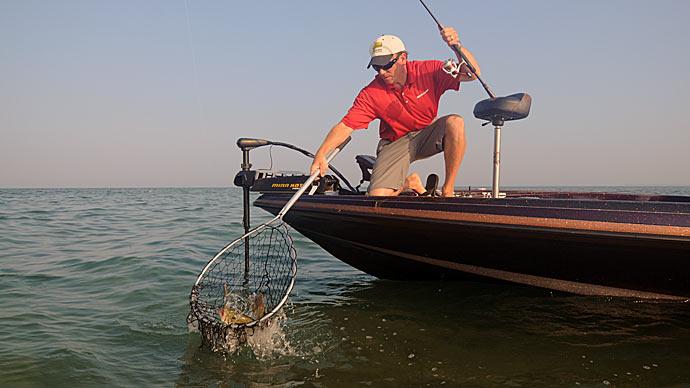
As the spawn wraps up, many big females transition from shallow water spawning sites to deep water summertime locations. Many bass will be suspended off the bottom during May and June on Lake Fork. By suspended, I mean the bass will be hanging out about 10- to 30-feet below the surface in 20- to 50-feet deep water. These bass are held in the water column's middle instead of on the bottom or near the surface. Many anglers assume suspended bass are inactive, non-feeding fish, and nearly uncatchable. On the contrary, suspended bass feed heavily during the post-spawn and early summer and often hold near big baitfish schools. The trick is finding a lure that you can keep in front of them.
Finding suspended bass is the easy part. Big schools of suspended fish show up well on your depth finder over main lake structures such as points, humps, and roadbeds. Mark the school on your graph, drop a marker buoy over the side, and you're set. In addition, many bass suspend in the timber over deeper water near spawning areas and on main lake points and flats. These fish are somewhat harder to mark on your graph, so scouting will take time to find the best places. To shorten your search, start in timber close to coves where lots of bass spawned in March and April.
Choosing the correct lure to catch suspended bass is a more complex decision, determined by the depth of the bass, how much cover is present, the type of forage the bass are eating, and weather conditions. Following is a list of my favorite baits and presentation for suspended lunkers.
The first category of baits is for more open water areas. If the conditions are windy or overcast, a shad or bluegill colored deep diving crankbait is hard to beat if the bass are holding 10 feet to about 18 feet below the surface. If the bass are too deep to reach with a crankbait, then shad- or bluegill-shaped swimbaits will go as deep as you need to go. Count them down to the desired depth and reel them through the fish on a steady swimming retrieve or a hop-and-drop retrieve to simulate fleeing prey.

One of the most productive baits on Fork over the years for suspended bass is a Lake Fork Tackle Magic Shad rigged on a 3/8- to ¾-ounce jighead. This year, the new 3.5 inch and 4.5 inch Live Magic Shad in the Barfish, Magic Shad, or Albino Shad colors, rigged on a 1/8- to ¾-ounce jighead, gives even more action to this old favorite and will work for suspended bass eating shad or yellow bass in any depth range. Just like swimbaits, count the Magic Shad or Live Magic Shad down to the depth of the fish and slowly roll your bait through the school.
No discussion of suspended bass will be complete without mentioning the old standbys of heavy metal-jigging spoons and tail, spinners-especially if the bass are eating shad. While hopping these lead dudes through schools of bass often work well, a new category of baits, called underpins, will often catch them even better. Try one of the new Sworming Hornet Fish Head Spins or Blackmore's Rollin' Runner tipped with a shad-colored Magic Shad or Live Magic Shad, and you'll give the bass a new look.

For bass suspended in heavy timber, there are several excellent options. First and foremost, a jig pitched to deep timber is a lethal weapon. I use a 3/8- or ½-ounce Mega Weight jig with a Fork Craw or Flipper trailer. For bass chasing shad, a white jig and trailer work best, while a more bluegill-looking color scheme works best for those chasing sunfish. Go with a pumpkin pepper, watermelon, green pumpkin, black/brown amber jig, sour melon, watermelon candy, watermelon/chartreuse pepper, Junebug, or green pumpkin trailer.
You want your jig to drop vertically next to trees, so let it fall on a slack line and trim down your trailer to a more compact size (for example, I cut off the antennae and the legs on the Fork Craw). The streamlined trailer and slack line prevent your bait from gliding horizontally and keep it in the strike zone.
Another great option around trees is a Ring Fry, Magic Shad, Zig Zag, or Live Magic Shad rigged on a 1/16- to ¼-ounce weighted hook. With the weight pre-mounted on the shank, Hooks will allow the lure to remain horizontal while slowly falling vertically next to cover, a deadly tactic when less active bass won't chase a fast-falling jig. Finally, a Carolina rig with a 3/8- to 1-ounce weight and a short 12- to 24-inch leader will crawl through branches and trees very well. Lighter weights come through the trees better, while heavier weights allow you to work the bait faster in more open water.
Make a long cast into the timber and let the bait fall to the bottom. Slowly crawl the bait up through the trees, letting it fall back down on slack line once you come over a limb, repeating this process back to the boat. Most strikes come as you approach a limb or just after you come across it. I prefer baits with a lot of swimming action for this setup, like the Lake Fork Tackle Baby Fork Creature or Live Magic Shad. Shad or barfish colors work well for the Live Magic Shad, while watermelon red, watermelon candy, bull bream, and purple haze work best for the Baby Fork Creature.
If you can't catch the bass shallow or deep this summer, give suspenders a try, and you might like the results. Here's hoping you catch the lunker of your dreams.




